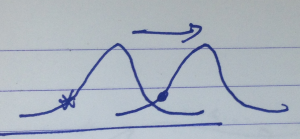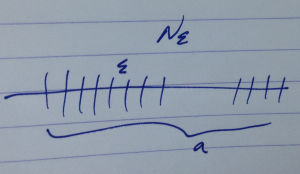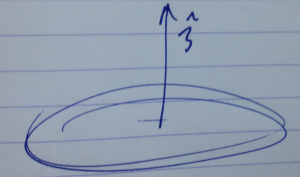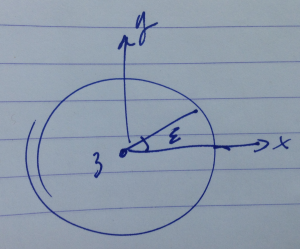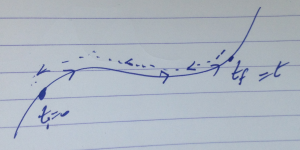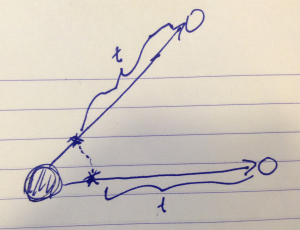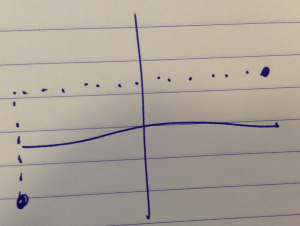[Click here for a PDF of this post with nicer formatting]
DISCLAIMER: Very rough notes from class, with some additional side notes.
These are notes for the UofT course PHY2403H, Quantum Field Theory I, taught by Prof. Erich Poppitz fall 2018.
Symmetries
Given the complexities of the non-linear systems we want to investigate, examination of symmetries gives us simpler problems that we can solve.
- “internal” symmetries. This means that the symmetries do not act on space time \( (\Bx, t) \). An example is
\begin{equation}\label{eqn:qftLecture7:20}
\phi^i =
\begin{bmatrix}
\psi_1 \\
\psi_2 \\
\vdots \\
\psi_N \\
\end{bmatrix}
\end{equation}
If we map \( \phi^i \rightarrow O^i_j \phi^j \) where \( O^\T O = 1 \), then we call this an internal symmetry.
The corresponding Lagrangian density might be something like
\begin{equation}\label{eqn:qftLecture7:40}
\LL = \inv{2} \partial_\mu \Bphi \cdot \partial^\mu \Bphi – \frac{m^2}{2} \Bphi \cdot \Bphi – V(\Bphi \cdot \Bphi)
\end{equation} - spacetime symmetries: Translations, rotations, boosts, dilatations. We will consider continuous symmetries, which can be defined as a succession of infinitesimal transformations.
An example from \(O(2)\) is a rotation
\begin{equation}\label{eqn:qftLecture7:60}
\begin{bmatrix}
\phi^1 \\
\phi^2 \\
\end{bmatrix}
\rightarrow
\begin{bmatrix}
\cos\alpha & \sin\alpha \\
-\sin\alpha & \cos\alpha \\
\end{bmatrix}
\begin{bmatrix}
\phi^1 \\
\phi^2
\end{bmatrix},
\end{equation}
or if \( \alpha \sim 0 \)
\begin{equation}\label{eqn:qftLecture7:80}
\begin{bmatrix}
\phi^1 \\
\phi^2 \\
\end{bmatrix}
\rightarrow
\begin{bmatrix}
1 & \alpha \\
-\alpha & 1\\
\end{bmatrix}
\begin{bmatrix}
\phi^1 \\
\phi^2
\end{bmatrix}
=
\begin{bmatrix}
\phi^1 \\
\phi^2
\end{bmatrix}
+
\alpha
\begin{bmatrix}
\phi^2 \\
-\phi^1
\end{bmatrix}
\end{equation}
In index notation we write
\begin{equation}\label{eqn:qftLecture7:100}
\phi^i \rightarrow \phi^i + \alpha e^{ij} \phi^j,
\end{equation}
where \( \epsilon^{12} = +1, \epsilon^{21} = -1 \) is the completely antisymmetric tensor. This can be written in more general form as
\begin{equation}\label{eqn:qftLecture7:120}
\phi^i \rightarrow \phi^i + \delta \phi^i,
\end{equation}
where \( \delta \phi^i \) is considered to be an infinitesimal transformation.
Definition: Symmetry
A symmetry means that there is some transformation
\begin{equation*}
\phi^i \rightarrow \phi^i + \delta \phi^i,
\end{equation*}
where \( \delta \phi^i \) is an infinitesimal transformation, and the equations of motion are invariant under this transformation.
Theorem: Noether’s theorem (1st).
If the equations of motion re invariant under \( \phi^\mu \rightarrow \phi^\mu + \delta \phi^\mu \), then there exists a conserved current \( j^\mu \) such that \( \partial_\mu j^\mu = 0 \).
Noether’s first theorem applies to global symmetries, where the parameters are the same for all \( (\Bx, t)\). Gauge symmetries are not examples of such global symmetries.
Given a Lagrangian density \( \LL(\phi(x), \phi_{,\mu}(x)) \), where \( \phi_{,\mu} \equiv \partial_\mu \phi \). The action is
\begin{equation}\label{eqn:qftLecture7:160}
S = \int d^d x \LL.
\end{equation}
EOMs are invariant if under \( \phi(x) \rightarrow \phi'(x) = \phi(x) + \delta_\epsilon \phi(x)\), we have
\begin{equation}\label{eqn:qftLecture7:180}
\LL(\phi) \rightarrow \LL'(\phi’) = \LL(\phi) + \partial_\mu J_\epsilon^\mu(\phi) + O(\epsilon^2).
\end{equation}
Then there exists a conserved current. In QFT we say that the E.O.M’s are “on shell”. Note that \ref{eqn:qftLecture7:180} is a symmetry since we have added a total derivative to the Lagrangian which leaves the equations of motion of unchanged.
In general, the change of action under arbitrary variation of \( \delta \phi\) of the fields is
\begin{equation}\label{eqn:qftLecture7:200}
\begin{aligned}
\delta S
&=
\int d^d x \delta \LL(\phi, \partial_\mu \phi) \\
&=
\int d^d x \lr{
\PD{\phi}{\LL} \delta \phi
+
\PD{(\partial_\mu \phi)}{\LL} \delta \partial_\mu \phi
} \\
&=
\int d^d x \lr{
\partial_\mu \lr{ \PD{(\partial_\mu \phi)}{\LL} } \delta \phi
+
\PD{(\partial_\mu \phi)}{\LL} \partial_\mu \delta \phi
} \\
&=
\int d^d x
\partial_\mu \lr{ \frac{\delta \LL}{\delta(\partial_\mu \phi)} \delta \phi }
\end{aligned}
\end{equation}
However from \ref{eqn:qftLecture7:180}
\begin{equation}\label{eqn:qftLecture7:220}
\delta_\epsilon \LL = \partial_\mu J_\epsilon^\mu(\phi, \partial_\mu \phi),
\end{equation}
so after equating these variations we fine that
\begin{equation}\label{eqn:qftLecture7:240}
\delta S = \int d^d x \delta_\epsilon \LL = \int d^d x \partial_\mu J_\epsilon^\mu,
\end{equation}
or
\begin{equation}\label{eqn:qftLecture7:260}
0 = \int d^d x
\partial_\mu \lr{ \frac{\delta \LL}{\delta(\partial_\mu \phi)} \delta \phi – J_\epsilon^\mu },
\end{equation}
or \( \partial_\mu j^\mu = 0 \) provided
\begin{equation}\label{eqn:qftLecture7:280}
\boxed{
j^\mu =
\frac{\delta \LL}{\delta(\partial_\mu \phi)} \delta_\epsilon \phi – J_\epsilon^\mu.
}
\end{equation}
Integrating the divergence of the current over a space time volume, perhaps that of cylinder (time up, space out) is also zero. That is
\begin{equation}\label{eqn:qftLecture7:300}
\begin{aligned}
0
&=
\int d^4 x \, \partial_\mu j^\mu \\
&=
\int d^3 \Bx dt \, \partial_\mu j^\mu \\
&=
\int d^3 \Bx dt \, \partial_t j^0 –
\int d^3 \Bx dt \spacegrad \cdot \Bj \\
&=
\int d^3 \Bx dt \, \partial_t j^0 ,
\end{aligned}
\end{equation}
where the spatial divergence is zero assuming there’s no current leaving the volume on the infinite boundary
(no \(\Bj\) at spatial infinity.)
We write
\begin{equation}\label{eqn:qftLecture7:560}
Q = \int d^3x \partial_t j^0,
\end{equation}
and call this the on-shell charge associated with the symmetry.
Spacetime translation.
A spacetime translation has the form
\begin{equation}\label{eqn:qftLecture7:320}
x^\mu \rightarrow {x’}^\mu = x^\mu + a^\mu,
\end{equation}
\begin{equation}\label{eqn:qftLecture7:340}
\phi(x) \rightarrow \phi'(x’) = \phi(x)
\end{equation}
(contrast this to a Lorentz transformation that had the form \( x^\mu \rightarrow {x’}^\mu = {\Lambda^\mu}_\nu x^\nu \)).
If \(\phi'(x + a) = \phi(x) \), then
\begin{equation}\label{eqn:qftLecture7:360}
\phi'(x) + a^\mu \partial_\mu \phi'(x) =
\phi'(x) + a^\mu \partial_\mu \phi(x) =
\phi(x),
\end{equation}
so
\begin{equation}\label{eqn:qftLecture7:380}
\phi'(x)
= \phi(x) – a^\mu \partial_\mu \phi'(x)
= \phi(x) + \delta_a \phi(x),
\end{equation}
or
\begin{equation}\label{eqn:qftLecture7:580}
\delta_a \phi(x) = – a^\mu \partial_\mu \phi(x).
\end{equation}
Under \( \phi \rightarrow \phi – a^\mu \partial_\mu \phi \), we have
\begin{equation}\label{eqn:qftLecture7:400}
\LL(\phi) \rightarrow \LL(\phi) – a^\mu \partial_\mu \LL.
\end{equation}
Let’s calculate this with our scalar theory Lagrangian
\begin{equation}\label{eqn:qftLecture7:420}
\LL = \inv{2} \partial_\mu \phi \partial^\mu \phi – \frac{m^2}{2} \phi^2 – V(\phi)
\end{equation}
The Lagrangian variation is
\begin{equation}\label{eqn:qftLecture7:440}
\begin{aligned}
\evalbar{\delta \LL}{\phi \rightarrow \phi + \delta \phi, \delta\phi = – a^\mu \partial_\mu \phi}
&=
(\partial_\mu \phi) \delta (\partial^\mu \phi) – m^2 \phi \delta \phi – \PD{\phi}{V} \delta \phi \\
&=
(\partial_\mu \phi)(-a^\nu \partial_\nu \phi \partial^\mu \phi) + m^2 \phi a^\nu \partial_\nu \phi + \PD{\phi}{V} a^\nu \partial_\nu \phi \\
&=
– a^\nu \partial_\nu \lr{ \inv{2} \partial_\mu \partial^\mu \phi – \frac{m^2}{2} \phi^2 – V(\phi) } \\
&=
– a^\nu \partial_\nu \LL.
\end{aligned}
\end{equation}
So the current is
\begin{equation}\label{eqn:qftLecture7:600}
\begin{aligned}
j^\mu
&=
(\partial^\mu \phi) (-a^\nu \partial_\nu \phi) + a^\nu \LL \\
&=
-a^\nu \lr{ \partial^\mu \phi \partial_\nu \phi – \LL }
\end{aligned}
\end{equation}
We really have a current for each \( \nu \) direction and can make that explicit writing
\begin{equation}\label{eqn:qftLecture7:460}
\begin{aligned}
\delta_\nu \LL
&= -\partial_\nu \LL \\
&= – \partial_\mu \lr{ {\delta^\mu}_\nu \LL } \\
&= \partial_\mu {J^\mu}_\nu
\end{aligned}
\end{equation}
we write
\begin{equation}\label{eqn:qftLecture7:480}
{j^\mu}_\nu = \PD{x_\mu}{\phi} \lr{ – \PD{x^\nu}{\phi} } + {\delta^\mu}_\nu \LL,
\end{equation}
where \( \nu \) are labels which coordinates are translated:
\begin{equation}\label{eqn:qftLecture7:500}
\begin{aligned}
\partial_\nu \phi &= – \partial_\nu \phi \\
\partial_\nu \LL &= – \partial_\nu \LL.
\end{aligned}
\end{equation}
We call the conserved quantities elements of the energy-momentum tensor, and write it as
\begin{equation}\label{eqn:qftLecture7:520}
\boxed{
{T^\mu}_\nu = -\PD{x_\mu}{\phi} \PD{x^\nu}{\phi} + {\delta^\mu}_\nu \LL.
}
\end{equation}
Incidentally, we picked a non-standard sign convention for the tensor, as an explicit expansion of \( T^{00} \), the energy density component, shows
\begin{equation}\label{eqn:qftLecture7:540}
\begin{aligned}
{T^0}_0
&=
-\PD{t}{\phi}
\PD{t}{\phi}
+\inv{2}
\PD{t}{\phi}
\PD{t}{\phi}
– \inv{2} (\spacegrad \phi) \cdot (\spacegrad \phi)
– \frac{m^2}{2} \phi^2 – V(\phi) \\
&=
-\inv{2} \PD{t}{\phi} \PD{t}{\phi}
– \inv{2} (\spacegrad \phi) \cdot (\spacegrad \phi)
– \frac{m^2}{2} \phi^2 – V(\phi).
\end{aligned}
\end{equation}
Had we translated by \( -a^\mu \) we’d have a positive definite tensor instead.
